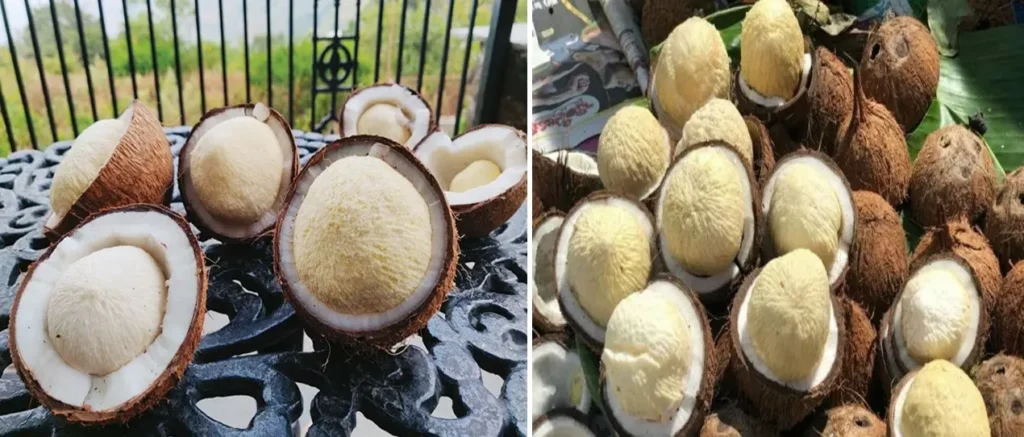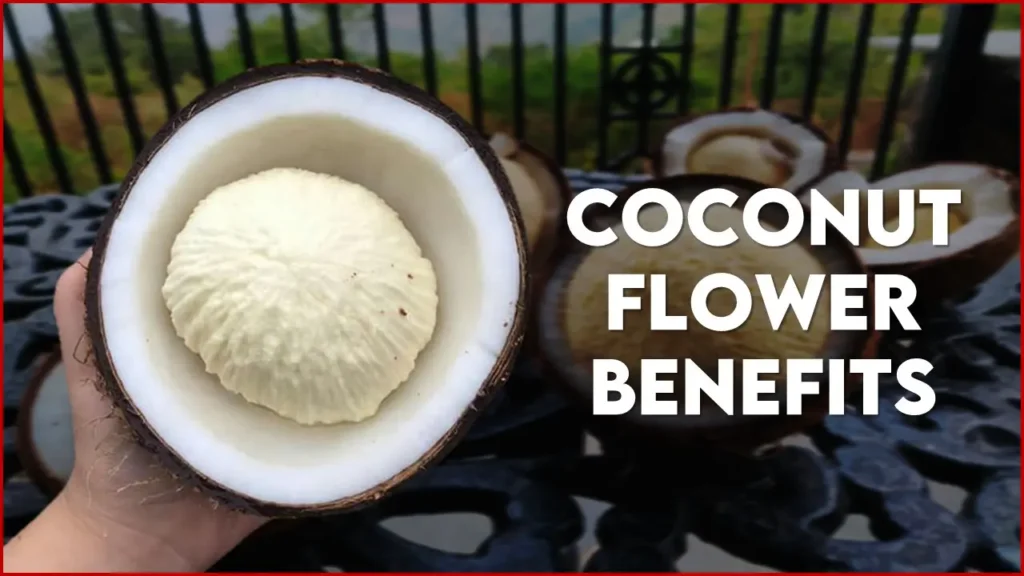The coconut palm, having the binomial name of Cocos nucifera, is one of the most beneficial trees in the world. The value each part of the coconut tree provides is astounding. Just think of drinking coconut water in the summer. It is one of those rare moments in a man’s life in which he/she feels satiation.
The direct and indirect benefits associated with the coconut tree and its parts are numerous. But there is a part that provides innumerable benefits but isn’t talked about often—the coconut flower.
The coconut flower is a part that is often overlooked when compared to other parts of the coconut. Coconut flower benefits are a topic that deserves to be explained. Various researchers have discovered numerous health benefits of flower inside coconut. This will be our top priority today. We will explore various benefits of coconut flower inside coconut by trying to answer the question: What are the benefits of coconut flower?
But first, let us look at what exactly is a coconut flower.
What is a Coconut Flower?
The Coconut Flower, also known as the inflorescence, is a part of the coconut palm (Cocos nucifera L.), which is a tropical, perennial palm.
Position: Each inflorescence is borne singly, emerging from the axil of successive leaves of a bearing palm.
Structure: The coconut inflorescence, called ‘spadix’, is 1-2 m long, and consists of a central axis or rachis, with 30 or more lateral branches called rachillae, each about 30-55 cm long. These rachillae bear 200-300 male flowers from the top down and some rachillae have one or more female flowers at their base. The total number of female flowers in an inflorescence is dependent on genetic and environmental factors and varies from zero (especially at the very first flowering) to a few hundred.
Appearance: The coconut palm is monoecious, with inflorescence bearing both staminate (male) and pistillate (female) flowers. The male flowers are the first to open, beginning at the top of each spikelet and proceeding towards the base. The male phase is followed by the female phase and in tall varieties, there is a gap between these two phases within the same inflorescence.
In terms of pollination, although both wind and insects bring about pollination, insect pollination is more predominant. Now let us turn our attention to the core of this discussion: the benefits of flower inside the coconut.

Let us look at the nutritional content of coconut flowers to understand the reason the flower in coconut benefits
Nutritional Content of Coconut Flowers
The Coconut Flower is a nutrient-dense superfood that offers a variety of health benefits.
Vitamins: Coconut flowers are a good source of Vitamin C, which is essential for the growth, development, and repair of all body tissues.
Minerals: They are rich in several important minerals, including iron, calcium, and potassium.
Dietary Fiber: The ripened coconut flower benefits are due to its high dietary fiber content, which improves digestive health by promoting regular bowel movements and preventing constipation.
Antioxidants: Coconut flowers contain antioxidants that protect cells from damage caused by free radicals and oxidative stress.
In addition to these, the budding coconut flower has a wonderful, sponge-like texture and is high in calcium, phosphorus, potassium, and fiber.
It’s important to note that while coconut flowers are nutritious, they should be consumed as part of a balanced diet.

Coconut Flowers Health Benefits
Here are the benefits of eating coconut flower.
1. Controls Diabetes
Diabetes is a long-term health issue, so consuming coconut flowers keeps it under control by satisfying the insulin sensation. Eating this flower is very good for blood sugar, brain, and bones. Coconut flour, which can be derived from coconut, is rich in dietary fiber. As it is low in carbohydrates compared to flour such as wheat and corn, it is useful for people with diabetes because it has a mild impact on blood glucose levels.
2. Coconut Flower Benefits in Pregnancy
Coconut flower has been traditionally used in various cultures and is believed to have several benefits during pregnancy:
- Uterine Cleansing: The petals of the coconut flower are believed to be good for uterine cleansing. This maintains the health of the uterus during pregnancy.
- Relief from Back Pain: Consuming coconut flower petals relieves back pain, a common discomfort experienced by many pregnant women.
- Improves Digestion: Coconut flowers might help improve digestion due to their high fiber content.
- Good for Skin and Hair: Coconut flower has the power to beautify the hair and the skin. This is beneficial as hormonal changes during pregnancy affect skin and hair health.
3. Coconut Flower Benefits for Conceiving
There is a very peculiar benefit for coconut flowers. According to traditional medicine, coconut flowers increase the chances of conception by boosting fertility. This is very beneficial for couples who are having a hard time trying for a new addition to the family.
- Uterine Cleansing: The petals of the coconut flower are good for uterine cleansing.
- Diabetes Management: Consuming honey from coconut sprouts reduces diabetes.
- Weight Management: Due to its high fiber content, coconut flower helps in weight management.
- Prevents Constipation: The pollen in the coconut flower prevents constipation.
This unique coconut flower benefit will surely make lots of couples happier. In fact, What is more merrier than bringing a new life into the family? The wonders of nature never stop mesmerizing us.
4. Coconut Flower Benefits Ayurveda
Ayurveda, the globally renowned Indian traditional system of medicine, gives a valuable position to the coconut flower because of its benefits.
The petals of the coconut flower are beneficial for uterine cleansing. This is beneficial as changes in the body’s internal environment affect skin and hair health. Coconut oil, extracted from the dried coconut (copra), is applied to the scalp for hair growth. Moreover, the flowers of the coconut are used in the prevention of frequent bowel movements in diarrhea and dysentery, and they help to normalize vitiated Pitta and Rakta (blood).
A tonic made from the coconut flower is a well-known Ayurvedic remedy. Furthermore, coconut water, which can be obtained from the endosperm of the coconut, is a natural coolant that calms the stomach, relieves gastritis and cleanses the urinary bladder.
5. Heals Bleeding Disorder
Coconut flower, particularly its sprouts, has beneficial effects on bleeding disorders. Here are some ways it might help:
Coconut flowers are beneficial for hemophilia. While the exact mechanism is not clear, it’s thought that certain components in the coconut flower help promote clotting and prevent excessive bleeding.
Consuming coconut sprouts is suggested for managing nosebleeds. Nosebleeds occur due to various reasons: dry air, nose picking, or an injury to the nose. The nutrients in coconut flowers strengthen the blood vessels in the nose and prevent nosebleeds. In Ayurveda, coconut water, flower, and tender coconut are indicated for bleeding disorders.
6. Helps Weight Loss
Weight loss is one among the coconut flower inside benefits. Coconut flowers are low in calories and high in fiber. The nutrients present in coconut flowers support metabolic function. Coconut flowers regulate blood sugar levels. The fiber and protein provided by eating coconut flowers maintain a constant and controlled appetite.
7. Helps in Healing Urinary Tract Disorders
Coconut flowers contain a long-chain lipid called lauric acid. Coconut water obtained from the endosperm of the coconut possesses diuretic properties. It increases the urine frequency and naturally flushes out the pathogen.
8. Prevents Heart Diseases
Studies suggest that the antioxidants found in coconut flowers lower cholesterol levels. Coconut flowers also contain fiber and potassium. Eating coconut flowers lowers blood sugar and total cholesterol levels in overweight individuals. Both high blood sugar and high cholesterol are risk factors for heart disease.
9. Prevents Diarrhea and Dysentery
In tropical regions, people cool down the rising body temperature by consuming coconut flowers. Consuming coconut flowers prevents stomach issues including bloody diarrhea and dysentery. The body can stay cool and fresh with the support of coconut flowers. One of the negative effects of diarrhea is dehydration. Consuming coconut flowers keeps the body hydrated.
10. Heals Leukorrhea
One of the benefits of coconut flowers is the fatty acids they contain, which help in the production and elimination of progesterone and estrogen.
Coconut flowers contain a long-chain lipid called lauric acid. While the exact mechanism is not clear, it’s thought that certain components in the coconut flower might help promote healing and prevent excessive bacterial growth.

Also Read
Uses of Coconut Flowers
The various uses of coconut flowers are
- Culinary Uses: Coconut flowers can be eaten fresh, cooked, or dried.
- Medicinal Benefits: Coconut flowers have several medicinal benefits.
- Nutritional Content: Coconut sprouts are rich in nutrients like fiber, calcium, potassium, phosphorus, etc. They are very good for blood sugar, brain, and bones.
- Healing Properties: Coconut flowers can help in healing many diseases.
- Weight Loss: Due to its high fiber content, coconut flowers can help in losing weight.
- Hair and Skin Benefits: Coconut flowers can prevent hair fall and give good strength to the hair.
- Cultural Significance: In some cultures, like in Kerala, India, coconut flowers are an indispensable item in auspicious moments.
- Other Uses: Apart from the above, coconut flowers are also used for decoration, and vinegar production, and are believed to bring good luck.
The coconut flower is an often overlooked, magical part of the coconut palm that possess the power to upgrade your health and ensure you lead a disease-free life. Consuming these flowers raw or as an ingredient in your diet can prevent diabetes, abnormal blood flow, diarrhea, dysentery, and chronic lifestyle diseases. In addition to this, the benefits of eating coconut flower ensures the health of the pregnant mother and child. Coconut flowers are indeed a wonder in the plant kingdom.
Latest Post
- Study Agriculture Abroad : A Complete Guide for USA
- July Issue (2024): Times of Agriculture Magazine
- Why Money Plant is called Money Plant ? Answer in 5 min
- How to grow Monstera from Cutting: 5-Step Detailed Guide
- Latest 10 Finest Terrace Garden Ideas to Transform Your Rooftops
- Top 10 Low Light Hanging Plants to make your Room Crunchy
- Best Water Harvesting Techniques for a Sustainable Future
- Low Maintenance Indoor Plants for India: 15 Best plants for home gardening
- Top 23 Flowering Trees in India: Flower Tree for Home












